From Farm to Field, and Every Point Between: How a Cow Becomes a Football

This story appears in the Jan. 28, 2019, issue of Sports Illustrated. For more great storytelling and in-depth analysis, subscribe to the magazine—and get up to 94% off the cover price. Click here for more.
Editor’s Note: This story contains descriptions from inside an animal slaughterhouse that some readers may find disturbing.
On a cold and snowy April morning in northwest Ohio, Tom Wagner prods a 1,200-pound steer with a four-foot-long wooden pole in a muddy holding pen. C’mon, you can do this. The red-and-white Holstein blinks at each annoying jab in his sides and hindquarters, fighting for every inch of the 20 or so feet that separate him and the rusty blue trailer parked by the barn’s door. Why are you making this so hard?
The beast, after nearly a half hour, is just a step away from the trailer but refuses to budge. So Wagner takes a thick rope and secures a metal gate behind the steer, pinning him in place. Dressed in worn blue jeans, a bulky tan Carhartt jacket and leather cowboy boots, the 59-year-old farmer climbs the gate and jumps onto the steer’s back. He doesn’t sit but stands, shifting his weight back and forth like a surfer finding his balance on a wave. Pick it up! Pick up your foot!
Only after dismounting and jamming the gate into the steer’s backside, over and over, is the task finally completed. The other steer in the trailer, a black-and-white Holstein, entered with little fuss but is now bawling loud—prolonged, almost mournful moos, as if he knows their fate. These steers are headed for slaughter, destined to become footballs. And five months from now an NFL equipment manager will place them in his quarterback’s hands so he can answer one question: Are they good enough for Sundays?
It sounds absurdly self-evident, but football can’t be played without footballs. And yet people rarely pay attention—Deflategate notwithstanding—to the one piece of equipment that has been the central figure in more than 1.5 million plays and counting since the NFL settled on an official ball in 1941. Measuring 11 inches in length and 22 inches in circumference at its widest point, an NFL football weighs between 14 and 15 ounces depending on the thickness of the four leather panels. On the outside, eight white laces are laid across the fat belly of the ball, and one panel is embossed with the league’s shield, the commissioner’s signature, the ball’s nickname (The Duke, after Giants patriarch Wellington Mara), and the manufacturer (Wilson). Inside, a rubber bladder is inflated to 13 PSI before it leaves Wilson’s factory in Ada, Ohio, where 130 employees make nearly 25,000 game balls for each new season. But not every official game ball will find its way into a pulsating stadium: About 20% end up on retail shelves and online stores, at about $100 a pop.
No matter where a ball ends up—in your backyard or in an NFL moment as indelible as the Immaculate Reception, Wide Right or the Butt Fumble—its journey starts on a farm and passes through the Windy City. The Horween Leather Company in Chicago is the only tannery that turns hides into leather for Wilson, with the vast majority coming from large ranches in Texas, Kansas, Nebraska or Ontario where the number of cattle can approach 400,000 head. The original conceit of this story was to find the cow that would become the football to kick off Super Bowl LIII. (The industry uses cow in the general bovine sense, as NFL balls always come from steers.) But tracing a hide’s journey through such a maze of mass production is all but impossible given the sheer volume of cattle involved in the process.
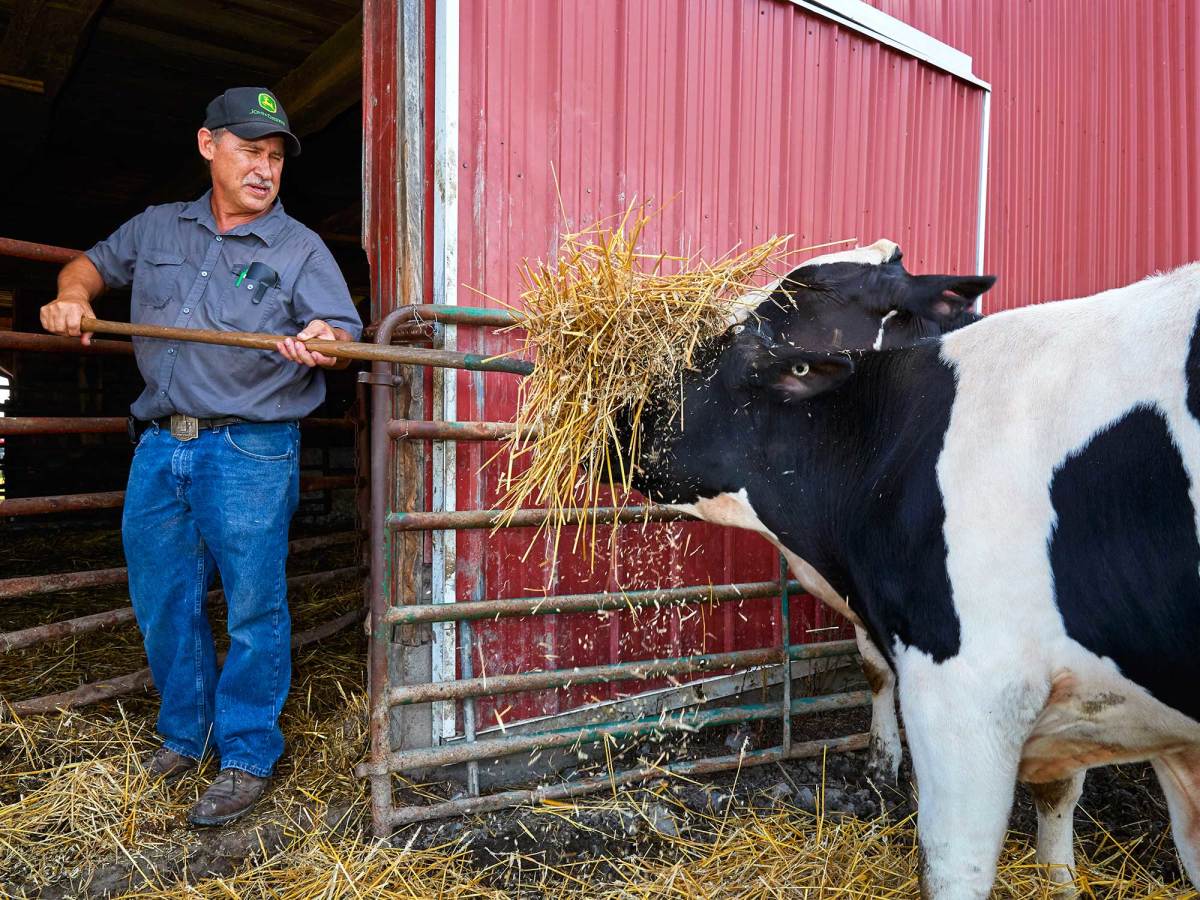
So The MMQB focused on a new target—a regular game ball that might be lucky enough to get a TV closeup on a first-down measurement—and the kind of smaller farm that occasionally sells cattle to larger corporations that in turn do business with Horween. And that’s how we ended up in Bluffton, Ohio, where Wagner grows corn and soybeans and raises cattle on more than 1,000 acres that have been in the family for over 100 years. Working alongside his brother and father, Tom rises at six every morning to feed and water the 10 head of cattle, keeping grain in front of them until he goes to sleep because the general rule is that steers will eat up to 30 pounds and gain three pounds per day.
The Holsteins in his trailer on this particular morning were purchased from 4-H kids at the county fair the previous fall and are now just over a year old, big enough to finally be “moved”—the farmer’s euphemism for what’s happening today—and turned for a small profit. Twenty minutes after getting the stubborn red one into the trailer, Wagner backs into the loading dock of a local slaughterhouse, where a cow’s head is perched atop other discarded parts in an orange steel barrel marked INEDIBLES. The swarming flies don’t heed the warning sign.
BASKIN: Remembering the Last Time Atlanta Hosted a Super Bowl...
In their early 30s, with matching boyish grins and short, scruffy beards, Clint and Cody Rodabaugh are the tall, wiry brothers wielding the butcher knives inside their butcher shop. They grew up on a nearby hog farm and graduated from Ohio State, with degrees in agricultural business and animal science, respectively. They’re wearing maroon rubber aprons over bluish-gray shirts and gray rubber boots that almost reach their knees; sheaths for their knives and steel sharpeners dangle from yellow, plastic chain-link belts.
The black-and-white Holstein is the first to enter the knock box, a small pen with an open top and metal sides that are taller than the “beef.” (Butchers always refer to livestock as consumer goods.) The metal walls act as blinders so steers can’t see the kill floor, where two carcasses are hanging from meat hooks in the ceiling. Cody, the younger brother, loads the bolt gun and climbs a wooden step stool, positioning himself directly over the beef. He takes aim at the middle of the forehead and pulls the trigger, sending a five-inch steel bolt straight into the skull—knocking the beef unconscious. The steer collapses to the ground, its limp tongue hanging out of its mouth. Cody then raises the sidewall of the knock box, and the beef slides out onto the floor, its back legs kicking out in a natural response as the nerves fire and the muscles twitch involuntarily.
Cody ties a chain around both hind legs and hoists the steer up to the ceiling, moving it into the kill room on a pulley track system. Now in a 600-square-foot space with white-tile brick, he positions a large basin on the concrete floor and makes one swipe across the beef’s neck. A few minutes later the blood slows to a trickle. When the flow stops, Cody cuts off the head, washes it and sets it on a hook to dry. The body is then lowered onto a short platform so Clint and two employees, nicknamed Slappy and Squatch, can set to work cutting off the hooves, legs and tail before tackling the innards. Steam rises from the beef, internal temperature 102°, as the crew begins to make small cuts to separate the hide.
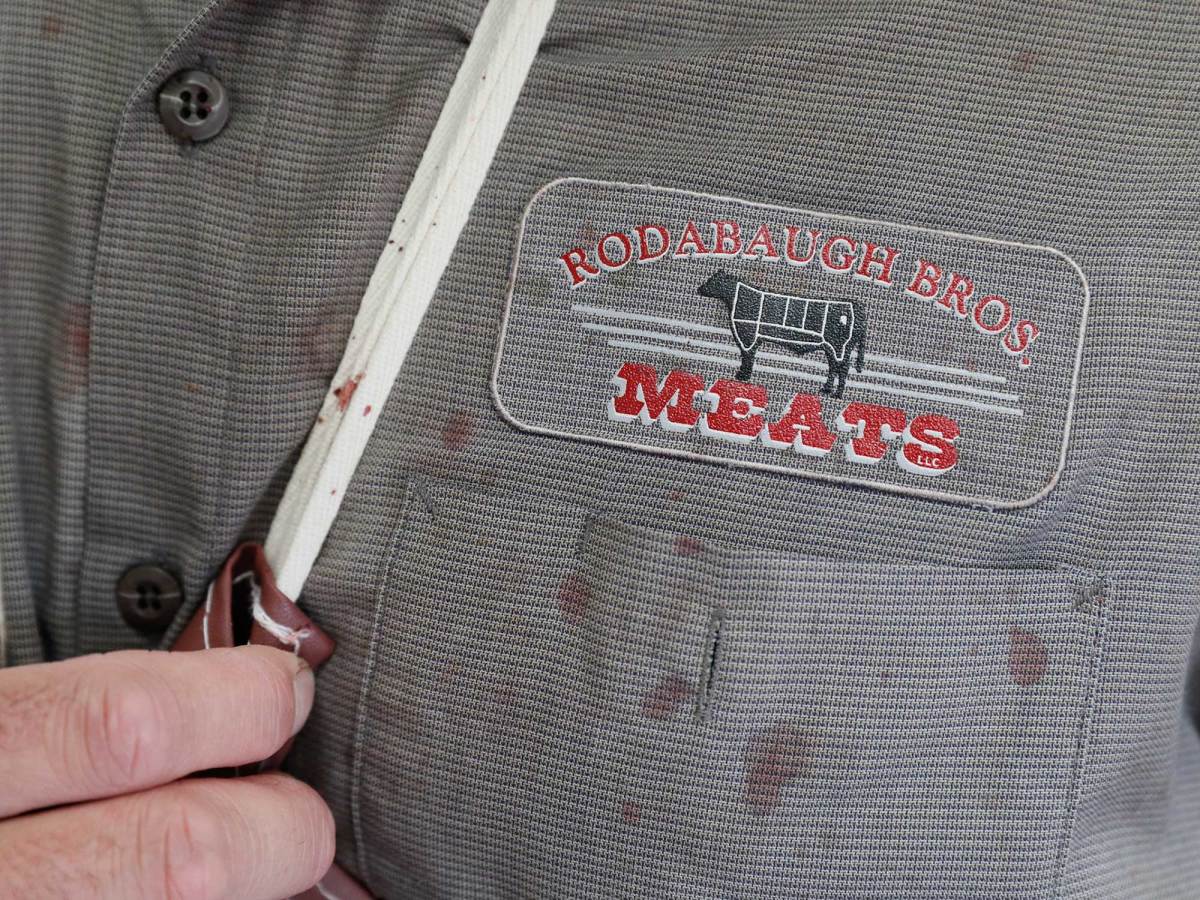
Kill days are Mondays and Thursdays, and today is just another Monday. Country music plays on the radio, and everyone sings along as the men work with the quickness and finesse of celebrity chefs chopping up vegetables. The odor of manure, hay and rubbery guts is everywhere, but that doesn’t stop Clint from eating lunch on the go, taking bites of a pork-belly sandwich. “It sticks in your nose hairs,” Cody says of the stench. “You never know if it’s you that smells—and if other people can smell you—or if it’s just that you’re still smelling it.” He doesn’t mind the work but prefers to not watch shows like Game of Thrones, wanting to escape the blood and guts when he’s off-duty. The hardest part about running this business, he says, is finding good employees because “nobody wants to do this kind of work for $12 an hour.”
To make the hide viable for an NFL football, the Rodabaughs use a mechanical hide puller, instead of knives, because any nicks or scores from them would disqualify it from being made into football leather. Fixed to the ground, the hide puller is a large roller with a two-ton motor that pulls sets of chains in opposite directions. One chain is attached to the meat; the other to the hide. The beef gets pulled toward the ceiling and the hide toward the floor, spooling it around the roller like Saran wrap.
Carl Gerten, 61, owner of Gerten Fur & Hides, will cure the hides before they are trucked to Chicago. So he and his youngest son, Jeremy, who manages the business aspects of the company, are on hand to make sure the hides are pulled with precision. The trick is to pull it evenly, so that the hide doesn’t become too thin in spots. As the motor whirs, the hide stretches like taffy and slowly peels away from the meaty red muscles. Once it’s fully off, Clint throws the hide into a white plastic barrel. Then he takes a massive saw hanging from the ceiling and splits the carcass down the middle, creating two halves of meat and bone that he rinses with bacteria-killing vinegar. Using all of his 195 pounds, he pushes each 380-pound section of hanging beef down the hallway to the freezer.
Back on the floor, the red-and-white steer is waiting in the knock box, having walked right in without making a scene this time.
After the second steer is butchered, everyone grabs a hose and washes down the floor, which is covered in a film of blood, manure and little bits of slippery white fat. The workers also wash down their aprons, boots, knives, saws, sharpeners and hooks. Squatch disappears and then quickly returns with a 30-pack of Busch Light, the usual routine after a busy kill day. Though these two steers have been earmarked for the NFL, there is nothing special about them. They are among the 1,400 cattle, 1,200 hogs and 400 deer that the Rodabaughs will slaughter in 2018, and all of that meat will help feed about 10,000 families throughout northwest Ohio.
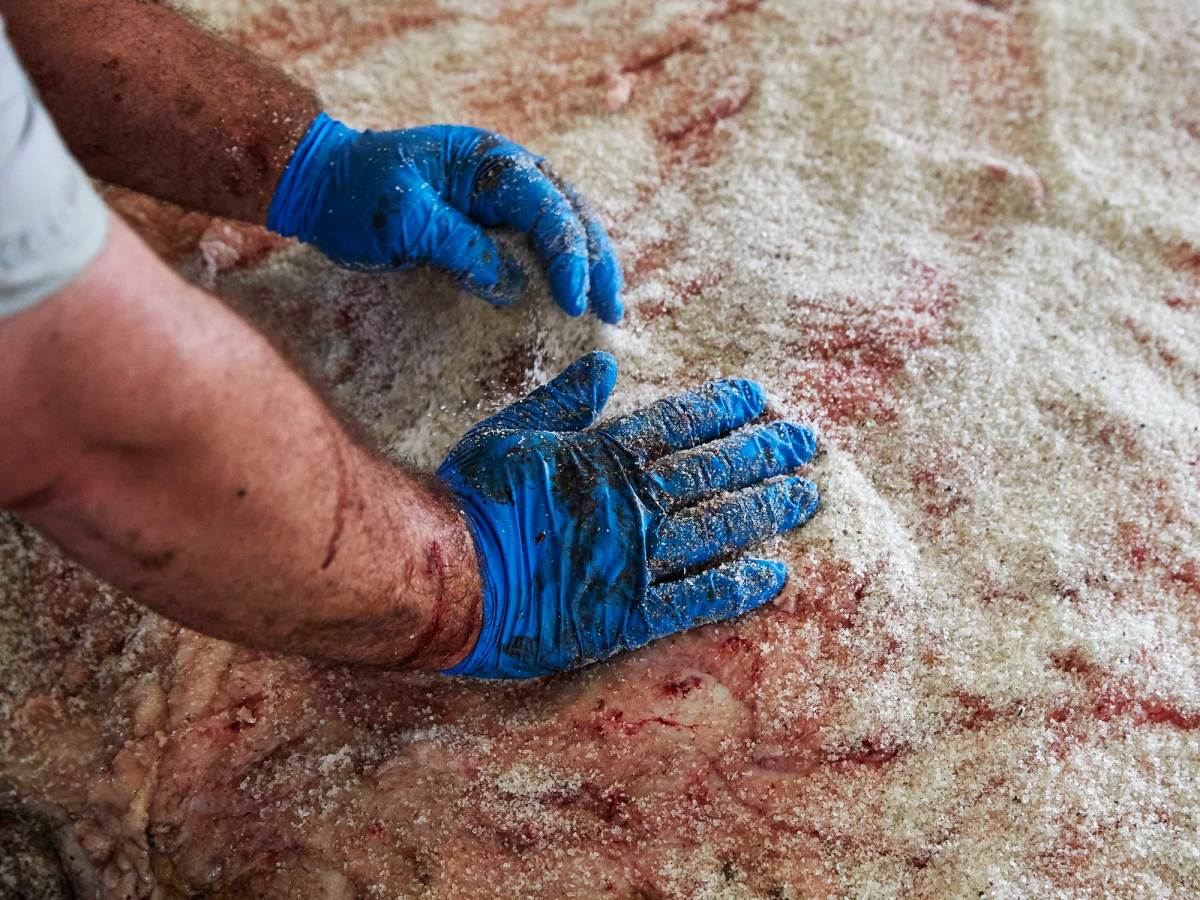
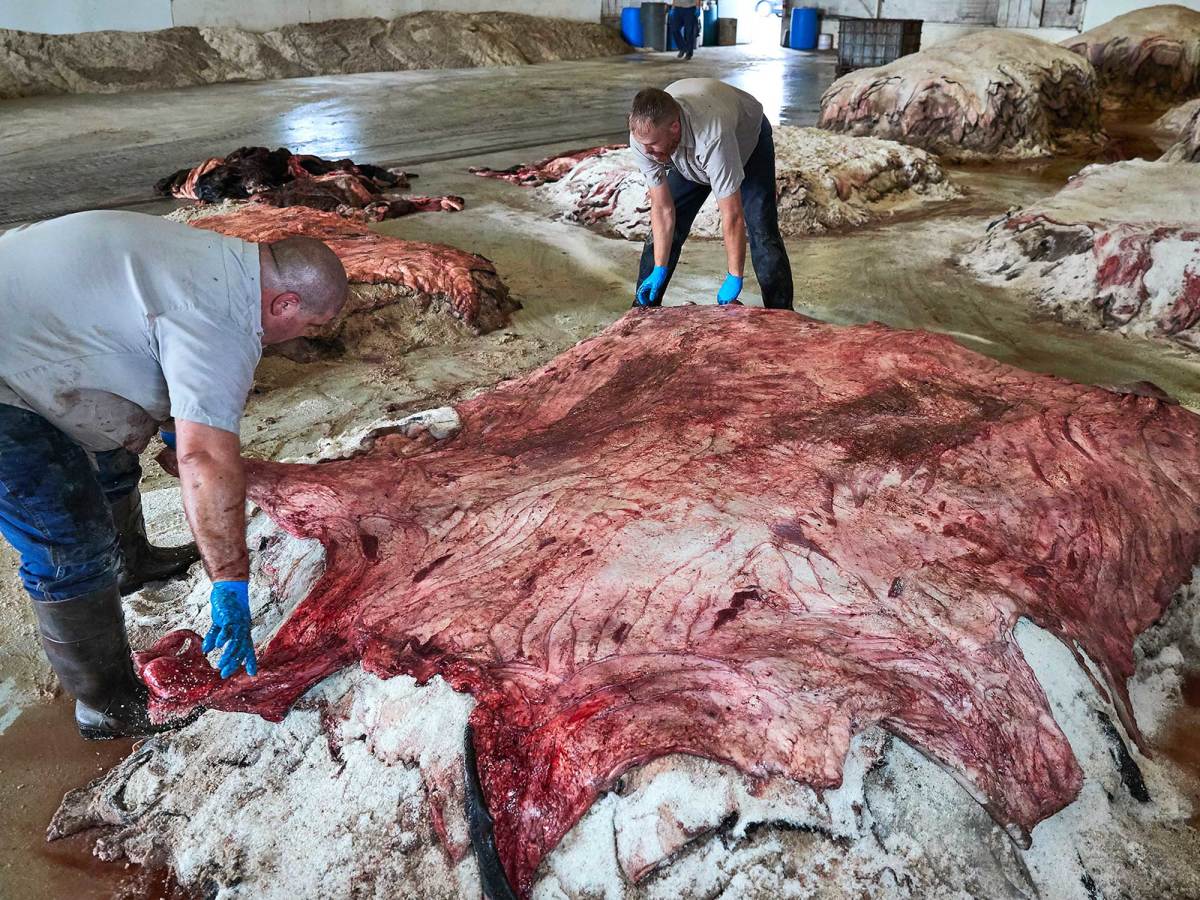
Wagner, who will keep some of his beef and sell the rest to family and friends, has been using this slaughterhouse for years but had never stayed to watch until now. “All of a sudden you see them drop to the ground and it’s like, O.K., this is kind of a reality-check in life,” he says. “But I felt nothing. It’s all part of production agriculture.”
The steer hides, weighing about 75 pounds apiece, are trucked to Gerten’s nearby warehouse. Some 3,000 deer and cattle hides are spread about the concrete floor in stacks of 60, the stench making the slaughterhouse seem like a botanical garden by comparison. Shovelfuls of salt are taken from a massive mound in the corner of the warehouse and dumped onto the meaty side of the hides, which are spread out flat on the ground, hair-side down. The salt is spread evenly by hand, just like smoothing the covers on a bed. Then the hides are folded up like a sleeping bag and placed back into the barrel. Hides normally sit in Gerten’s warehouse and cure for 10 days, but these two will be on a truck headed to Chicago in the morning.
ROHAN: For Rob Gronkowski, Hollywood Awaits. Can He Make It There?
The tannery has been operating out of the same factory on the west side of the Chicago River since 1920, but the only identifier on the nondescript brick facade is a small black sign mounted under a window that reads HORWEEN LEATHER CO.
Skip Horween, the 62-year-old company president, is part of the fourth generation to run the family business. He’s just returned from a trade show in Milan and is busy signing checks on a heavy wooden desk made from the recycled planks of old fishing boats. The whole building gives off the aroma of finished leather, and the memorabilia inside Skip’s wood-paneled office tells the story of the company’s history with Wilson and the NFL.
There’s a framed antique photo of his great-grandfather, Isadore, who founded the business in 1905 after emigrating from Ukraine. Isadore is standing next to his wife, Rose, and their two sons, Ralph and Arnold, who would grow up to play football at Harvard and then professionally for the Chicago Cardinals. (Arnold, Skip’s grandfather, was also a player-coach for the Cardinals.) Below the family photo there’s a black-and-white picture of Arnold with Knute Rockne at Harvard’s spring practice in ’29. Pro football was a small fraternity back then, and the Horween brothers were friendly with another Chicago player-coach: George Halas. That relationship is how the family business became the only leather supplier for Wilson, tanning every NFL football for the past 77 seasons. “How important is luck?” Skip says. “We just happened to know a guy.”
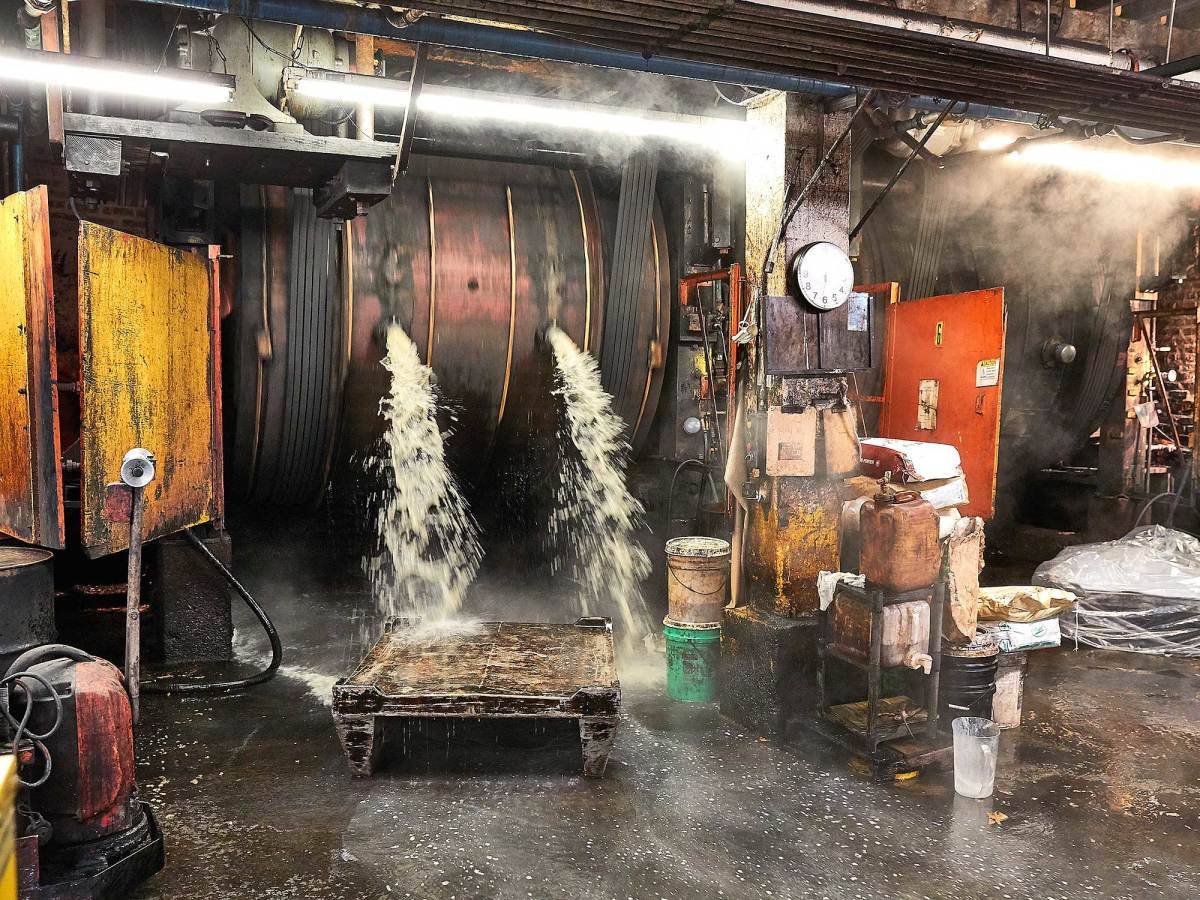
Our hides arrive at Horween a few days after the slaughter and are placed in the factory’s dark and stuffy basement. Employees punch a row of nickel-sized holes down the middle of each hide to track them throughout the process. First they go through a hair and flesh removal process that uses something like an industrial-strength Nair, made of sodium sulfide and lime. From there, the hides begin a three-step tanning process: bate, pickle and tan. Bating is an enzyme wash; pickling is done with an acid pre-tan solution; and the tanning uses a chrome mix, which turns hides into a shade of light blue, making them look like pieces of foam.
The light-blue hides are then dried and sorted into grades, from one (highest quality) to 10 (lowest, which is ideal for distressed or worn-in looks). Three employees share the task of determining where hides end up, running their hands over the surface and feeling for any holes, nicks or scratches. Baseball gloves are made of Grade 1 leather because there’s no finish on them, meaning the product must be flawless. Purses and jackets are Grade 2. Footballs are made from Grade 2 and 3 leather. (Horween also makes the leather for NBA basketballs, which are Grade 3.) Our hides, though a bit thin in spots, are graded as 3s because they don’t have any scars or holes. Thanh Vi Camh, 54, does the final inspection on our hides but doesn’t like to think about where the leather ends up. “Working is working,” he says. “Seeing the game is time off. No mixing. Mixing like that is no good.”
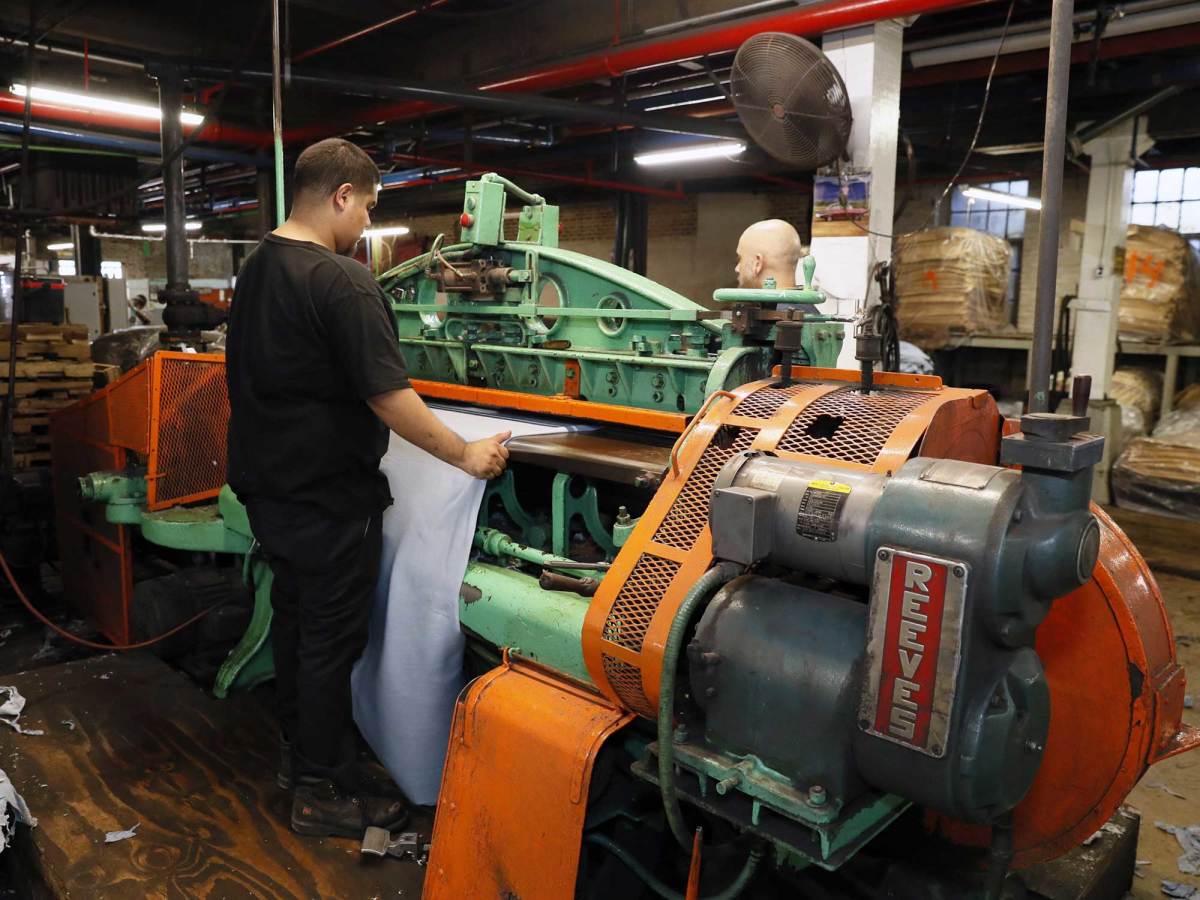

After being sorted, the hides are split into two pieces and shaved down to a uniform thickness, then re-tanned inside a metal drum that rotates for eight to 11 hours at 12 rpm. The hides come out a light shade of natural tan. After drying, they’re embossed by a 57,000-pound press with a football-specific design that has a few tiny Wilson W’s scattered throughout the pebbled pattern. Then the leather is spray-painted the deep-reddish brown hue of an NFL football. From start to finish, the process takes about three weeks.
When the transformed hides are packed up and ready for Wilson, they’re placed among boxes in Horween’s shipping area that are headed to fine shoemakers in England, Spain and Hong Kong. On a Tuesday morning in mid-June, the plant manager at Wilson, Pete Thompson, receives our two hides, now split into four panels. He looks them over and sends a text: “The initial inspection was very positive.”
But turning leather into a football is a complicated process, and we won’t know if our balls have made the cut until the very last step, when they’re inflated to 13 PSI, and the proper air pressure reveals any flaws that might have been previously overlooked.
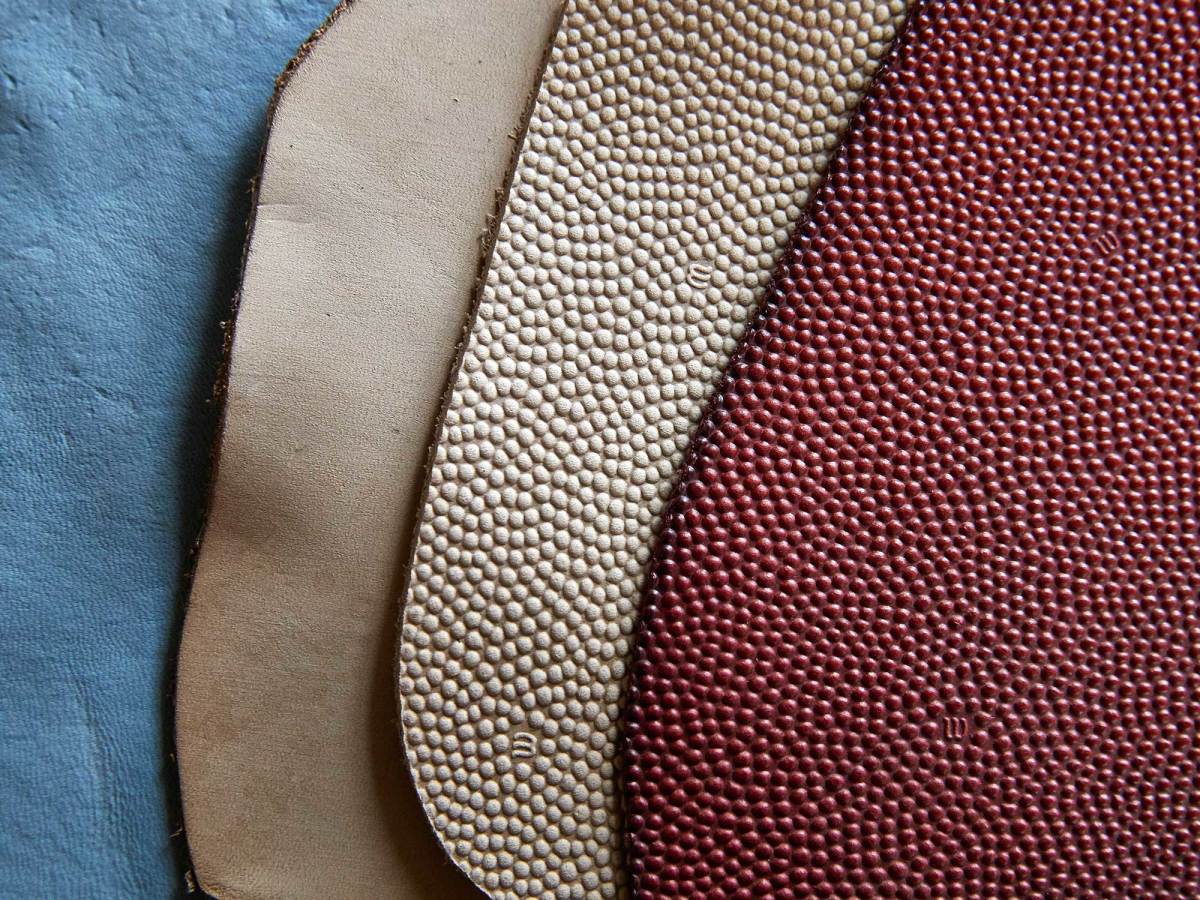
Footballs are the only product made at Wilson’s Ada plant, and the process hasn’t changed much since 1941. There are cutters, stampers, stitchers, turners, lacers, molders, inspectors and packagers—and virtually everything is done by hand over a three- to five-day process. Some two dozen people play a role in making each ball, and the plant processes up to 3,000 balls every day, so Wilson assigned an employee to track our footballs-in-the-making from station to station.
The cutters start the process by punching out the panels, four for each ball, with stencils that look like football-shaped cookie-cutters. (Typically, one hide will yield 10 to 12 footballs. And balls are always made from the same hide.)
The stampers take the panels and insert them into a loud machine that presses a shiny foil design—in this case, the NFL shield—onto the leather.
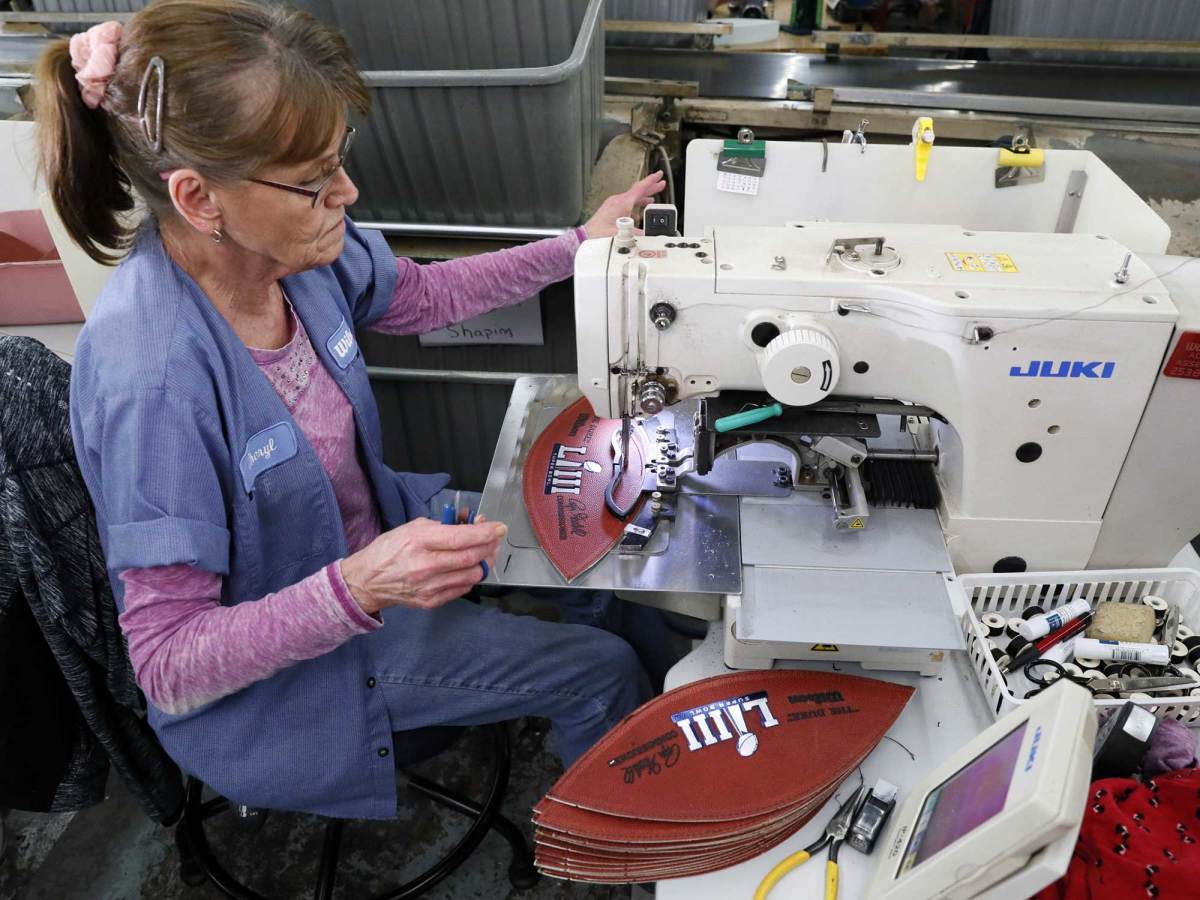
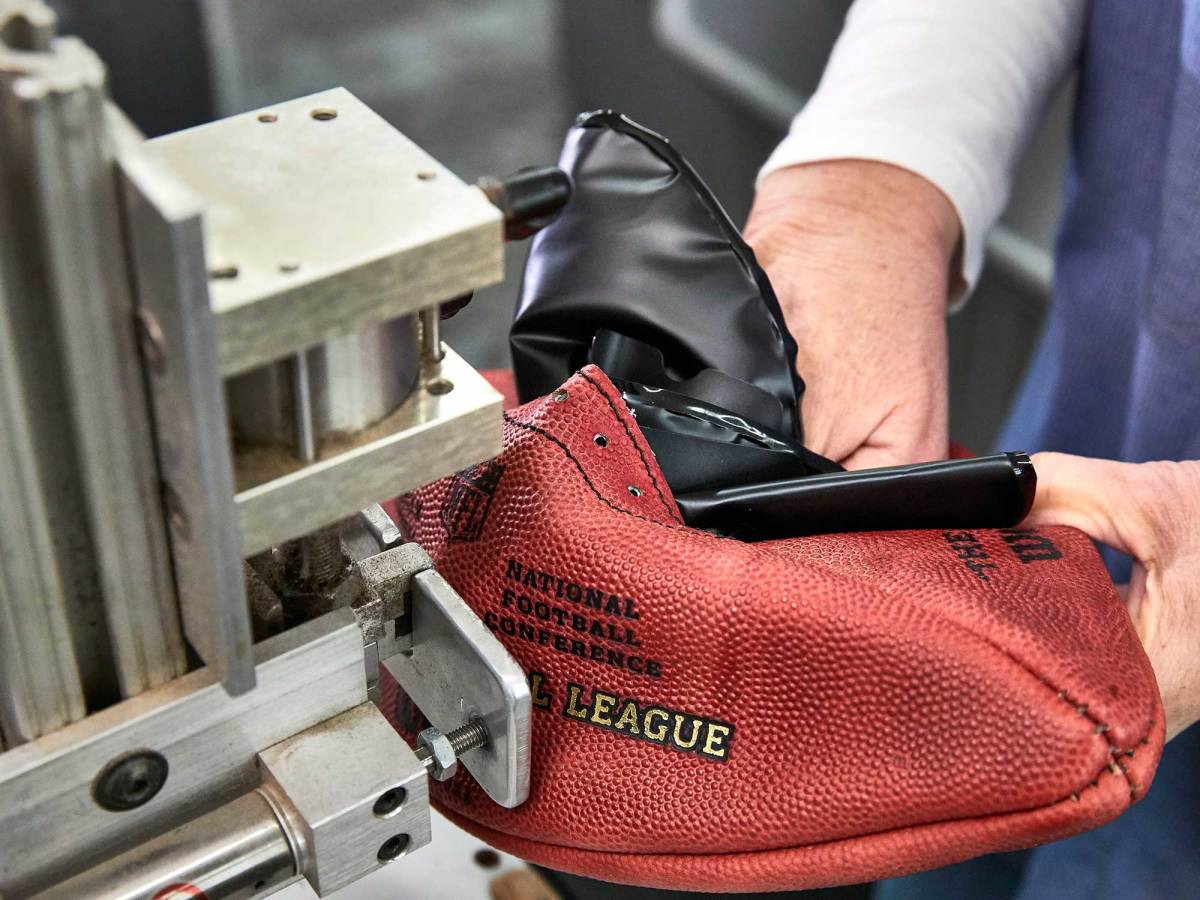
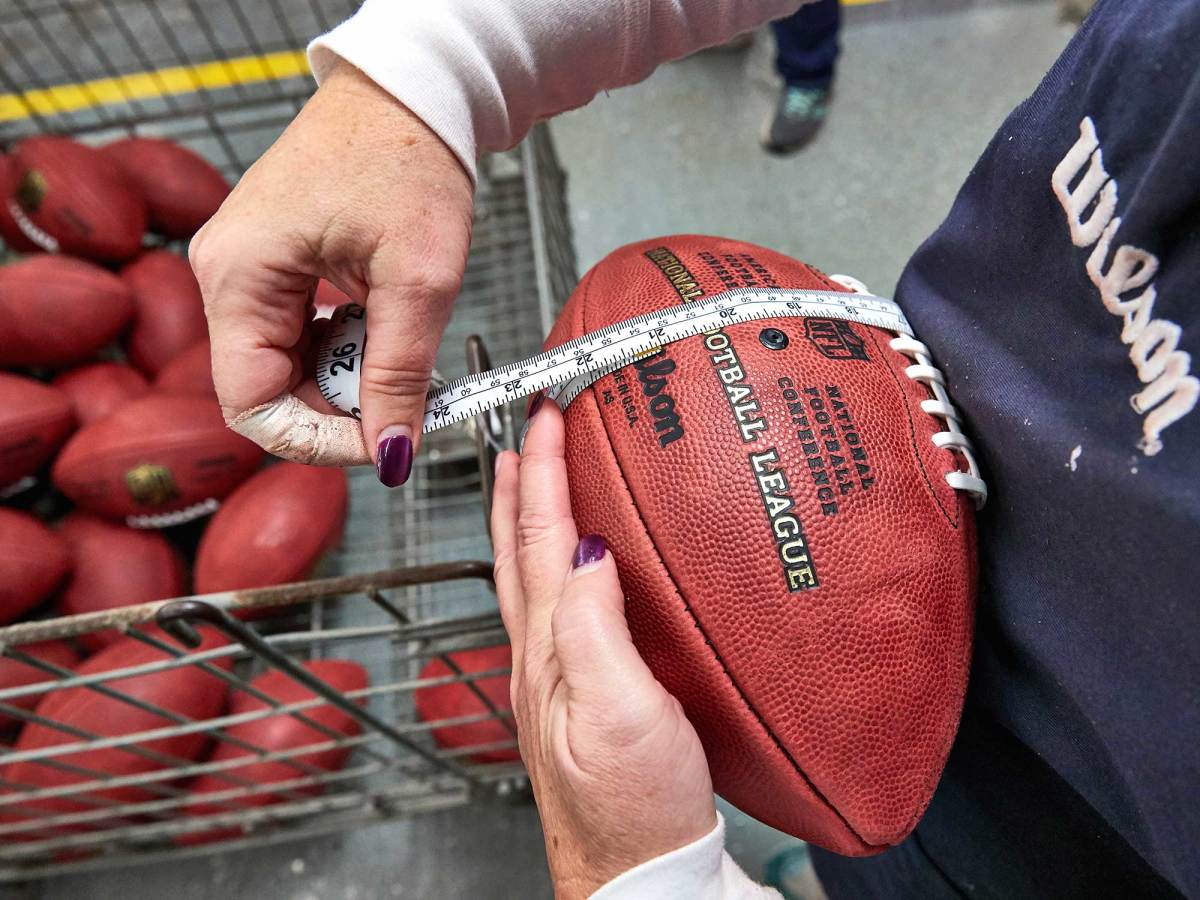
The stitchers operate loud, old-fashioned-looking sewing machines manufactured by Campbell Randall Leather Machine Company, which has been in business since 1858. Using the Union Lockstitch machine, they sew the four panels together inside out, so the seams don’t show, using two types of strong thread—a braided brown poly thread and a brown wax-lined polyester thread. (The sewing is so intricate that it can take a new employee three to five months to perfect the technique.)
The turners take the inside-out shells and wrestle them right-side out, the most physically demanding job in the process. They soften the balls inside a steam box, hammer in the two pointy ends of a football, and then place one end on the top of a pole attached to a table. Using the pole for leverage, they work the leather right-side out by pulling it through the gap where the laces will go. Each turner flips 500 to 600 balls a day.
The lacers place a rubber bladder inside the ball and then double-lace each ball closed, their fingertips wrapped in white athletic tape to get a better grip on the rough leather as they methodically weave the long white laces in and out.
The molders inflate the footballs to 13 PSI inside a special mold.
Finally, inspectors study each football closely to ensure every detail is functionally and cosmetically perfect. They sort the balls into three categories: game use, practice use (balls with slight cosmetic defects) or retail. (That’s right, official ”game balls” on store shelves never stood a chance of ending up in an NFL stadium.)
On a warm mid-August morning Wilson’s public relations director, Kristina Peterson-Lohman, emails us the final report: Our footballs didn’t make the cut.
VRENTAS: Brian Flores Opens Up About His Mother’s Cancer
Mike Kuehne, Wilson’s general manager of production, explains that the best of our leather had been turned into three footballs. But the final inspection revealed that they didn’t have the proper grip, or pebble definition. He says it is ”the most critical thing we look for. If you get balls that have a flat or smooth panel, our grading process would say that would be more of a retail product. It couldn’t be a game ball.”
Kuehne assigns one of our three footballs for retail, and it gets shipped to the distribution center for Academy Sports & Outdoors in Katy, Texas. It will be sold at one of the chain’s 249 locations to a buyer who will likely never think about where that football came from. One of the balls goes back to Wagner, a token of thanks for his help with this story. He keeps it on his mantle, next to a wooden sign that reads: GOD BLESS OUR FARM. Of his steers not making it to Sundays, he says with a laugh, “Sort of like every high school and college football star thinks he is going to be something in the NFL.” As for the third football, we set out to find a veteran NFL quarterback to see if he concurs with the inspectors at Wilson.
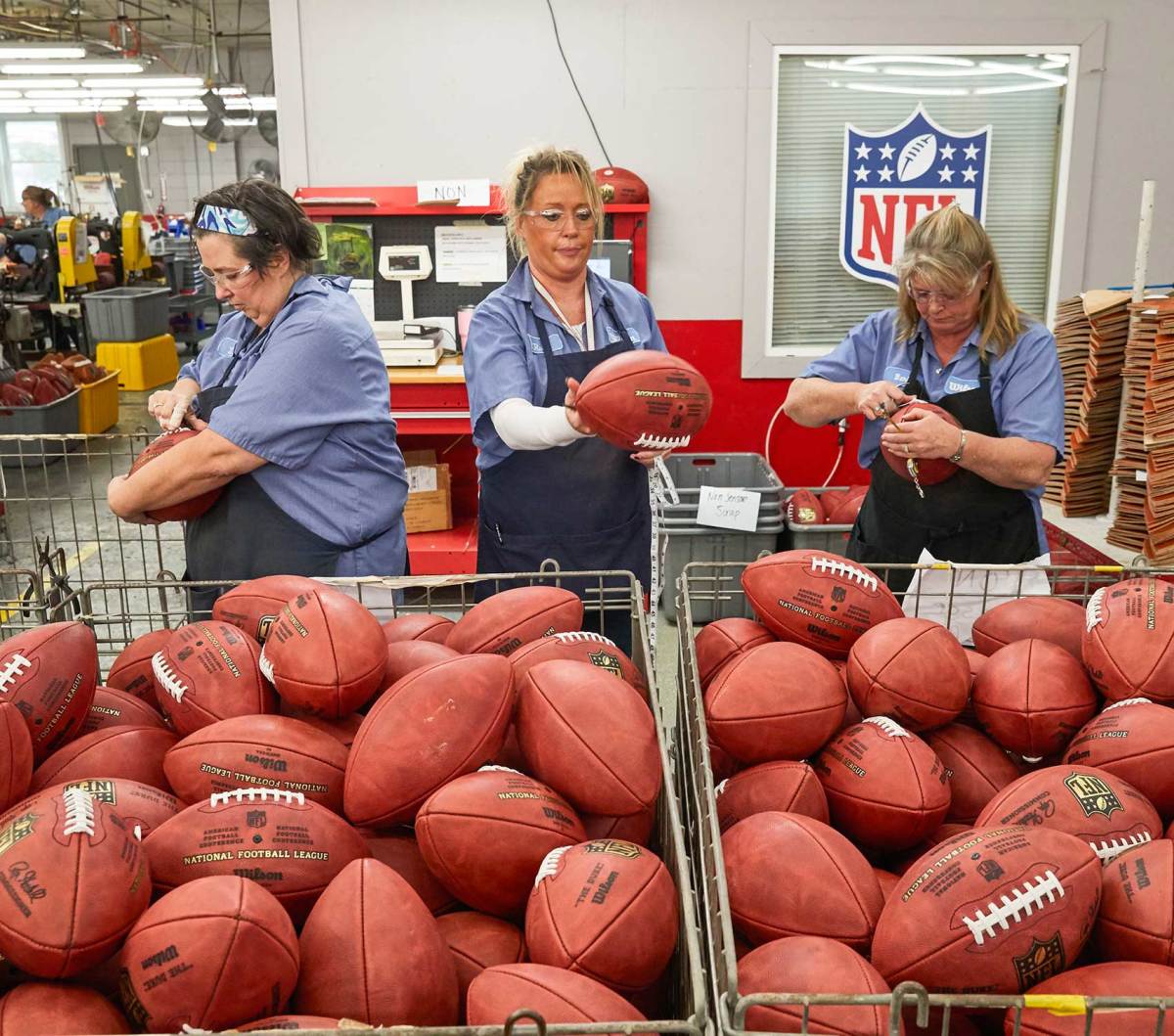
Tyler Runk wipes something wet off our football with a small white towel, but the Bengals’ assistant equipment manager won’t reveal the secret sauce. When the ball was delivered to Paul Brown Stadium the night before, it had a factory look and feel: reddish brown with a slightly sticky finish. Now that waxy look is gone and the ball appears darker, as if it’s been soaked in water. But it’s not water, and all Runk will say is that “there are 32 different teams and 32 different processes” when it comes to breaking in new footballs.
He’ll only divulge that the Bengals use a three-step process and that it takes an hour to condition each football. When he’s pressed for even the smallest of details, Runk laughs and changes the subject: “Hey, want to know what a long snapper thinks of your football?”
Clark Harris comes over to a large rectangular table in the center of the equipment room. There are two footballs to examine—one is an approved game ball, and the other is the ball that we have tracked from the farm. NFL players never handle factory-fresh footballs, so Runk has worked both up as if they were going to be used on Sunday Night Football. Harris, who’s been long-snapping for the Bengals since 2009 and made the Pro Bowl at the position last season, turns our football around in his hands, squeezing it and pushing it down on the table. “I would want this as a kicking ball!” he declares. Then he picks up the game-approved ball, which is more textured. “This is trash, this is terrible,” he says.
Our ball is a little smoother and feels a bit fatter than the game-approved ball. “You like it because it doesn’t have the nubs,” Runk says, referring to the pebble definition.
“Yeah, for kicking balls, we want those nubs all gone,” Harris says. “I want the nubs off because I wear gloves when I snap and it makes for total contact on the ball. We also want the balls as fat as humanly possible. When the balls are fat, it means they’re looser, and the punter and kicker can kick it farther.”
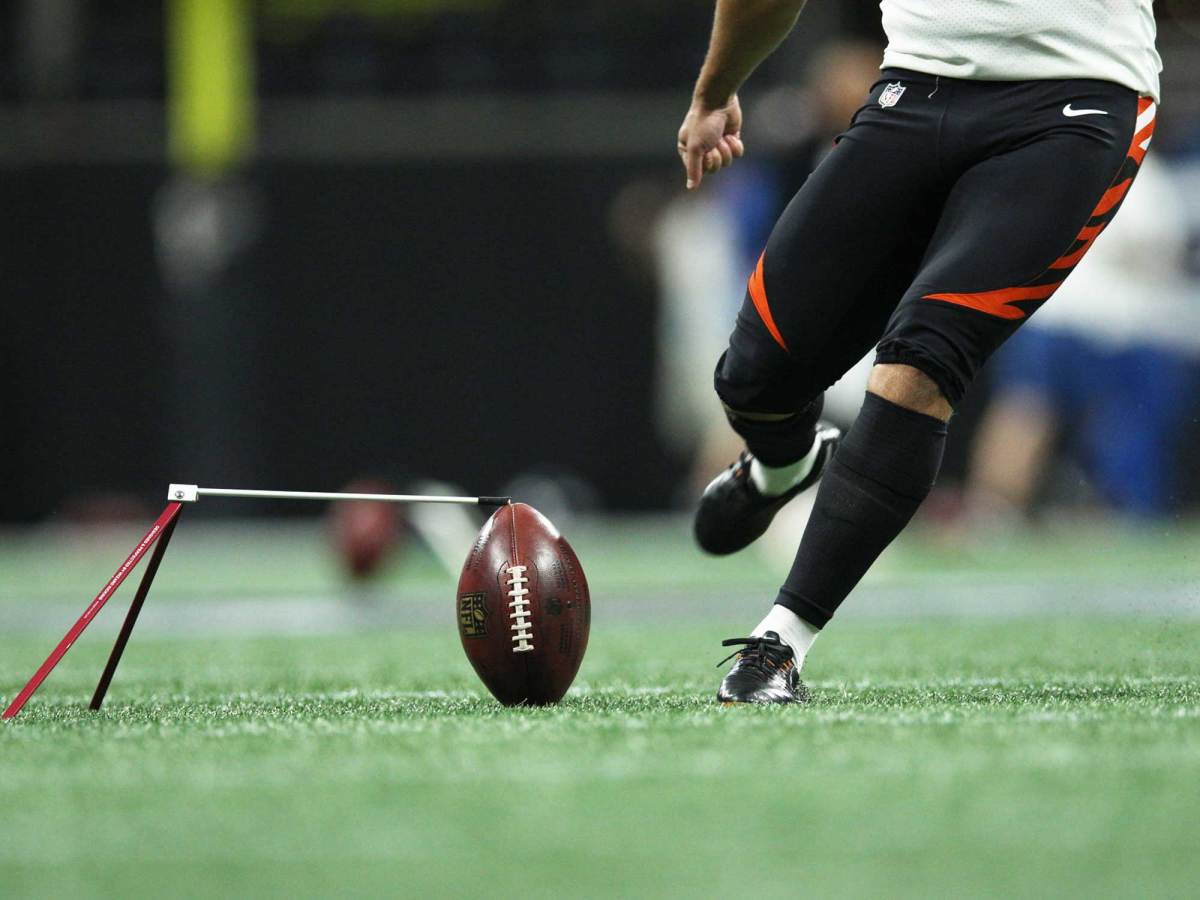
Wilson sends 780 footballs to each team every season, but the Bengals don’t come close to using all of them. When Runk goes through a new shipment to narrow down the best candidates to use in a game, he does so with the quarterback rather than the long snapper in mind. He wants balls that have that defined, grippy texture that ours lacks; he also wants the laces to be flat and sitting close to the surface.
Now to see what a quarterback thinks. After an easy Friday walk-through and a captains’ meeting, Andy Dalton is presented with both footballs on the stadium field. It’s a sunny and unseasonably humid day for late September. He holds them in his hands and knows almost instantly which one he prefers: the game-approved ball. At first glance, Dalton thinks ours is just an old, broken-in ball that has hung around too long. “You can see the beads on this one,” he says of the real game ball. “This other one has been rubbed down a lot.”
Every quarterback has his own preference for how he likes his footballs, a feel that Dalton started developing as a high school quarterback in Katy, Texas. (The same town where one of our three footballs was shipped.) “Very rarely will I be at practice and be like, ’Alright, get that ball out of there, it’s not very good,’” he says. When he’s told that the football he’s holding came from a fellow redhead, the red steer, Dalton laughs and adds, “I don’t know why it is called a pigskin.” (The answer to that bit of trivia: In the earliest days of football the balls were made from pig bladders, and the nickname has stuck ever since.)
On game days, each team presents the officiating crew with 24 game balls—12 primary footballs and 12 backups. Unless it’s raining or there are a lot of turnovers, it’s rare for a team to dip into the backup stock. (For the Super Bowl, each team gets 108 footballs that are made specifically for the championship game; from that haul they’ll select and present 24 balls to the officials before kickoff.) Each time a ball is approved for game use, the head official will initial it with a Sharpie. There’s no limit on how many times the same ball can be used in a game, but once a ball has been filled with roughly six signatures, it’s usually time for it to be put out to pasture. The Bengals’ equipment staff gives old game balls to the marketing department to use for autograph memorabilia, donation requests or fan events at the stadium.
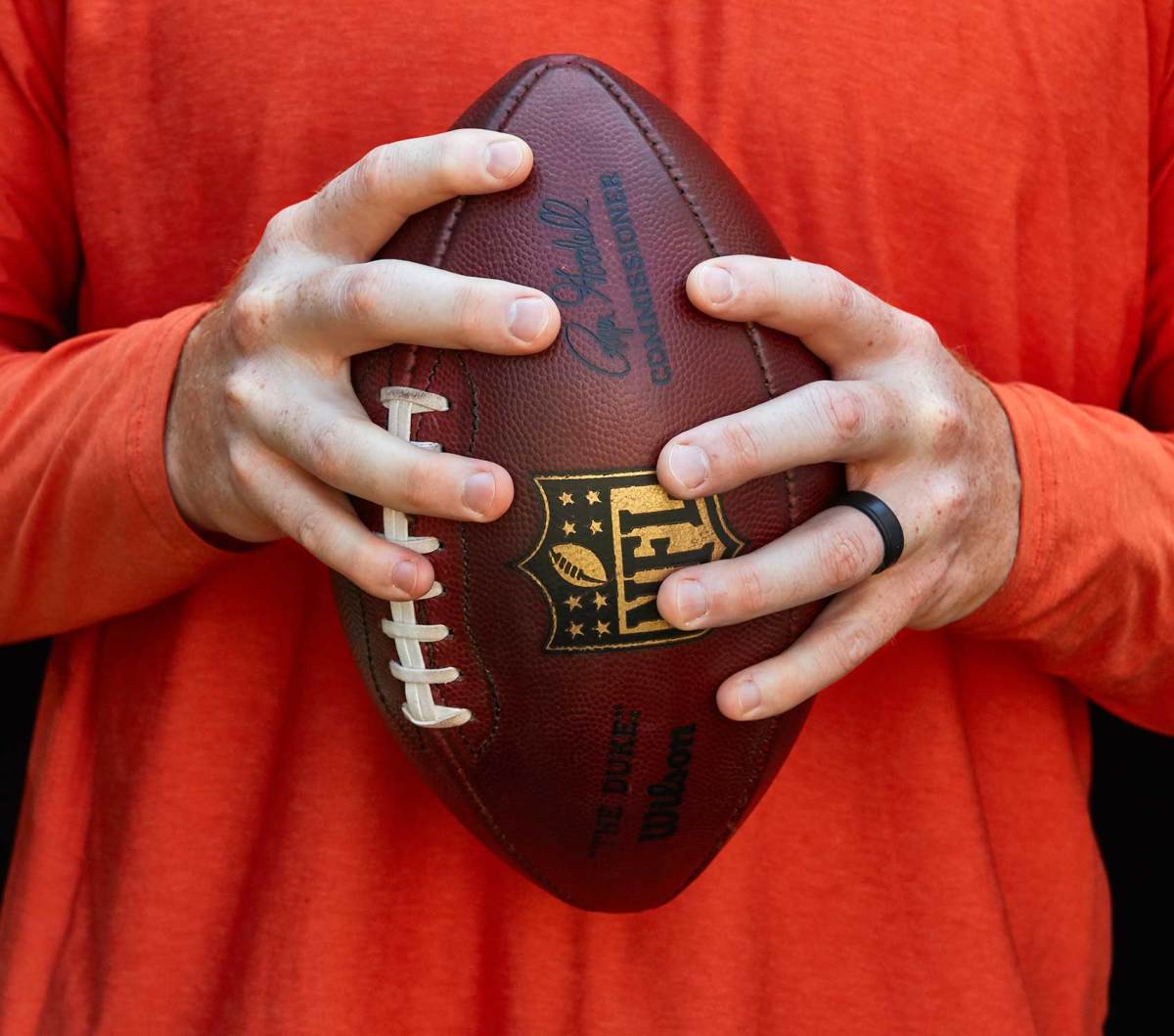
After throwing tight spirals with our ball to backup quarterback Jeff Driskel for a few minutes, Dalton gives us his verdict. “I could make it work,” he says. “But I wouldn’t want it.” Turning it around in his hands a bit more, he adds, “I feel like it is almost like a kicker ball. I’m sure the kickers and long snappers like this one.”
The Bengals’ equipment staff asks to keep our ball and adds it to the rotation of kicking balls. Runk marks the name of our NFL website in silver Sharpie—MMQB—underneath the league’s shield. The Bengals will use it in practice and in pregame warmups for three to four weeks, unless it gets kicked into the stands. But it will never see game action because of league rules.
In addition to the game balls, which teams work up during the week and supply to officials before the game, Wilson ships a box of game-approved footballs to the officiating crew’s hotel before each game. These are the kicking balls, or “K balls.” The officials bring them to the stadium, where the equipment staffs are allowed to start prepping them two hours and 15 minutes before kickoff. Teams are allowed to rub K balls down with a wet towel, brushes and tacky sponges—but nothing else. The NFL began this process in 1999 because kickers and punters had been manipulating footballs to gain a competitive advantage. Teams would put footballs in dryers, saunas and ovens, trying anything to make them softer and more pliable, which helps them travel farther. Even if our football had been game-approved by Wilson, it couldn’t have become a real kicking ball because it had already been worked on.
But our ball still had life.
MCKNIGHT: Rams CB Sam Shields’s Two-Year Journey Back From Concussion
It’s Week 4, and the Bengals are on the road in Atlanta. At precisely 11:33 a.m., Randy Bullock (yes, his last name is a synonym for steer) starts warming up for a 1 p.m. kickoff. Beginning with short kicks before working farther back, the placekicker sets our football upright at the 10-yard line, balancing it with the arm of a metal holder. Positioned a few yards behind the ball and to the left, he leans forward on his bent left leg and launches three steps toward the ball, left, right, left. He then swings his right leg like a pendulum and blasts the football into the air. The kick is good.
Bullock again uses our ball during warmups in Week 5 at home against Miami, but then it ... disappears. Runk says it wasn’t kicked into the stands, so there are only two possible explanations. It either got mixed up with the Dolphins’ footballs (their equipment staff doesn’t have it, they checked for us) or someone with a pregame field pass scooped it up (a heist!). Players give balls to fans all the time, but if you happen to have our football, we kindly ask that you do not treat it like a souvenir, leaving it on a shelf to collect dust. Take it out to play as often as possible. After all, it never really was a game ball. And spare a thought for a certain red-and-white Holstein from Ohio. You’re holding him in your hands.
Question or comment? Email us at talkback@themmqb.com.
